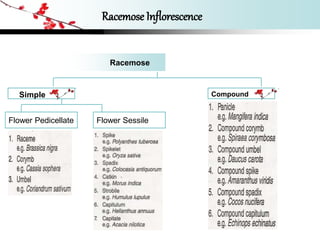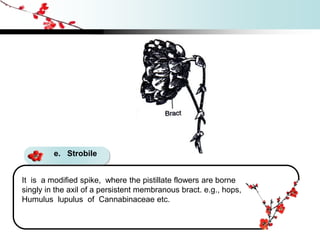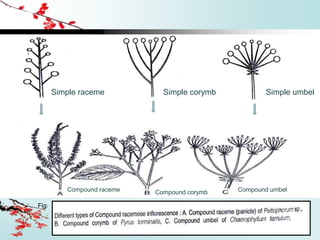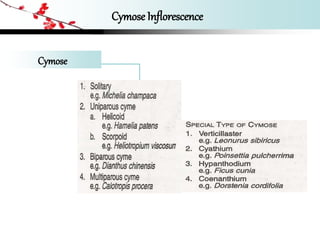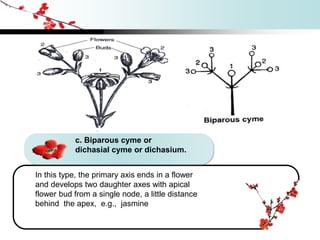Inflorescence
- 1. INFLORESCENCE Submitted by Arnab Mitra Dept. of Environmental Studies, Siksha-Bhavana,Visva-Bharati
- 2. content What is Inflorescence ?? The arrangement of flowers on the floral axis (shoot system) of a plant is called Inflorescence.
- 3. The main axis or stalkof a solitaryinflorescenceis calledthe PEDUNCLE. The main axis or stalkof a solitaryinflorescenceis calledthe PEDUNCLE . and the stalkof individualflower is called PEDICEL . A long , simpleor branched peduncle is called a RACHIS . The dilatedor flattenedpeduncle is called RECEPTACLE. The unbranched naked peduncle developingfrom the underground stem is called SCAPE or radical peduncle. The stage or platform on which the floral parts situatedis called THALAMUS.
- 4. Sometimes,the flowersas well as inflorescencesare subtended by an expanded leafy organ, called BRACTand flowershaving bract is called bracteate flower and withoutbract it is called ebracteate flower.Sometimes,very small thinbract-like(leafy or scaly ) structuresare developed on flowerstalkin between flowerand bracts,called bracteoles or secondary bracts. Bractsare of different types. Thses are : a. Leafy or Foliaceous e. Epicalyx b. Scaly f. Involucre c. Spathy g. Glume d. Petaloid h. Cupule BRACT
- 5. Fig:
- 6. 1. Racemose 3.Mixed 2.Cymose The combination of characteristics of both racemose and cymose types or of two types of racemose. This type is also called indefinite or indeterminate or botryose inflorescence. A racemose inflorescence is one whose rachis (simple or branched) never ends in a flower and it conti nues to elongate by means of a persistent growing point. Types of Inflorescence This type is also called definite or determinate infloresence. A cymose inflorescence is one whose rachis (simple or branched) becomes terminated by a flower bud at an early stage and subsequent buds are developed gradually towards the lower side of the axis.
- 7. Racemose Inflorescence Racemose CompoundSimple Flower Pedicellate Flower Sessile
- 8. Simple racemosetypes Flowers pedicellate (stalked) a. Raceme The main axis has indefinite growth, where more or less equally pedicellate flowers are borne, e.g., mustard, Brassica nigra etc.
- 9. b. Corymb The main axis is comparatively shorter and the lower flowers have much larger pedicels than the upper ones, so that all the flowers are brought more or less at the same level, e.g., cherry, Prunus cerasus of Rosaceae.
- 10. c. Umbel The main axis is much shortened and the flowers appear to develop from the same point. The older flowers are towards the periphery and the younger flowers towards the centre. 'Thus, it looks like an open umbrella. e.g., Indian pennywort, Centella asiatica.
- 11. a. Spike The main axis is of indefinite growth, where sessile flowers are borne on it.Here, elongated peduncle bears sessile flowers in an acropetal manner. e.g., long pepper, Piper longum of Piperaceae ; basak. Flowers sessile
- 12. b. Spikelet or locusta It is a compact type of inflorescence in which few flowers are contained by an axis, rachilla,at the base of which is occurred two sterile glumes, and at the base of each flowers is the fertile glume or lower palea or lemmas.just opposite and slightly above of lemma is an another glume called upper palea. e.g; rice, wheat,maize etc.
- 13. c. Spadix It is a spike with fleshy axis having both male and female flowers. Entire structure is surrounded by a large bract called spathe.The female flowers are always found towards the base of the axis and male flowers towards the apex, where the sterile flowers are situated between these two. The terminal portion is barren and called as appendix.e.g; Musa,Alocasia.
- 14. d. Catkin or amentum It is the pendulous spike with fleshy and delicate axis which bears naked unisexual flower that falls as a unit at maturity. Viz. hazel, Corylus sp. of Betulaceae.
- 15. e. Strobile It is a modified spike, where the pistillate flowers are borne singly in the axil of a persistent membranous bract. e.g., hops, Humulus lupulus of Cannabinaceae etc.
- 16. f. Capitulum or anthodium or head In this type, the main axis is much shortened and broadened out to form a flat or more or less convex receptacle on which numerous sessile and small florets are arranged in a centripetal manner i.e., youngest at the centre and oldest towards the periphery. Individual florets are bracteate. e.g., sunflower.
- 17. g. Capitate In this type, a dense cluster of sessile flowers arise upon a compressed rachis; thereby they give rise to a somewhat globose structure. e.g.,Mimosa pudica.
- 18. Compound racemose type a. Compound raceme or panicle Each branch of the main axis develop a cluster of stalked flowers like the raceme. Viz. Peltophorum ferrugineum When branches of the main axis bear corymbs, it is called compound corymb e.g.,Spiraea corymbosa b. Compound corymb It consists of many,small umbels instead of a single umbel. Small bracts of secondary umbels together form an involucre, e.g.,carrot c. Compound umbel When branches of the main axis bear spikes, it is called compound spike, e.g., Amaranthus viridis d. Compound spike The fleshy axis is repeatedly branched and each branch bears sessile unisexual flowers., e.g., coconut. e. Compound spadix The capitulum is composed of many small capitula,surrounded by involucre of bracts, e.g., Echinops echinatus of Asteraceae. f. Compound capitulum
- 19. Fig: Simple raceme Simple corymb Simple umbel Compound raceme Compound corymb Compound umbel
- 21. a. Solitary It is the simplest type of cymose. Here the rachis is unbranched and always terminated by a flower, e.g; Hibiscus rosa-sinensis of Malvaceae etc.
- 22. b. Uniparous cyme or monochasial cyme or monochasium. In this type, the primary axis ends in a flower and gives rise to only one daughter axis, which behaves as the mother. It is of two types : i. Helicoid cyme or bostryx. ii. Scorpioid cyme
- 23. c. Biparous cyme or dichasial cyme or dichasium. In this type, the primary axis ends in a flower and develops two daughter axes with apical flower bud from a single node, a little distance behind the apex, e.g., jasmine
- 24. d. Multiparous cyme or polychasial cyme or polychasium or pleiochasium. In this type, the primary axis ends in a flower and develops more tha n two daughter axes wi th apica l flower bud from a si ngle node, a little distance behind the apex. The daughter axes, in their turn, also behave like mother, e.g., Kleinhovia hospita
- 25. a. Verticillaster It is a condensed cymose inflorescence, each occurs in the axil of opposite leaves having sessile or slightly stalked flowers. Each rnflorescence is initially a dichasial cyme and the two lateral sides become reduced to two scorpioid cymes .The entire inflorescence appears like a cluster of sessile flowers forming a false whorl at the node, e.g., Leucas linifolia. Special types of cymose inflorescence
- 26. b. Cyathium It is a specialised cymose inflorescence,but looks like a single flower. The axis becomes suppressed to form a convex receptacle. In the centre of the receptacle, there is a long-stalked, naked female flower with tricarpellary gynoecium, surroundedy a large number of male flowers arranged in a scorpioid cyme .The male flowers consist of a single stamen , joined to a short stalk i.e., the pedrcel and each one develops in the axri of a hairy bracteole. The enti re inflorescnce is surrounded by a cup-shaped green involucre formed by the union of bracts. The involucre is with one or two nectar glands on its outer wall or often without gland. The flowers are developed in centrifugal manner i.e., from inner to outer side, e.g ; , Poinsettia pulcherrima of Euphorbiaceae. Special types of cymose inflorescence
- 27. c. Hypanthodium In this type, a hollow sphere-like receptacle (syconium) is formed by the fusion of the rachis of three closely placed cymes. The spherical receptacle is like a closed fleshy vessel with a small open ing at the apex. Three types of unisexual flowers (ma le, fertile female and sterile female) are arranged on the inner surface of the receptacle in cymose groups, e.g., fig., Ficus cunia. Special types of cymose inflorescence
- 29. Fig:
- 30. Fig:
- 31. contentReferences Books 1. BIOLOGY PLANTAE Subhash Vikal Dr. Devendra Kumar © Target media 2008 2. A TEXTBOOK OF BOTANY Bhattacharya Hait Ghosh © NCBA
- 32. Thank you







